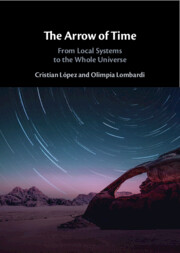Book contents
- The Arrow of Time
- The Arrow of Time
- Copyright page
- Contents
- Contributors
- Preface
- Acknowledgments
- Part I Local Systems
- Part II The Arrow of Time and Philosophical Issues
- 4 Explaining the Psychological Arrow of Time in Time-Symmetric Physics
- 5 The Consequence Argument Meets the Mentaculus
- 6 “Freedom from the Inside Out”: Revisited
- 7 The Arrow of Time Is Alive and Well but Forbidden under the Received View in Physics
- Part III The Arrow of Time and Time-Reversal Invariance
- Part IV The Whole Universe
- Index
- References
5 - The Consequence Argument Meets the Mentaculus
from Part II - The Arrow of Time and Philosophical Issues
Published online by Cambridge University Press: 28 October 2025
- The Arrow of Time
- The Arrow of Time
- Copyright page
- Contents
- Contributors
- Preface
- Acknowledgments
- Part I Local Systems
- Part II The Arrow of Time and Philosophical Issues
- 4 Explaining the Psychological Arrow of Time in Time-Symmetric Physics
- 5 The Consequence Argument Meets the Mentaculus
- 6 “Freedom from the Inside Out”: Revisited
- 7 The Arrow of Time Is Alive and Well but Forbidden under the Received View in Physics
- Part III The Arrow of Time and Time-Reversal Invariance
- Part IV The Whole Universe
- Index
- References
Summary
The “Consequence Argument” has spawned an enormous literature in response. The most notable of these responses is David Lewis’ which is based on his account of counterfactuals. My reason for adding to this literature is that I show that while Lewis’ diagnosis of the argument is on the right track, the account of counterfactuals he relies on to rebut the argument is defective and, consequently, he rejects the wrong premise of the argument. I will develop a response that is in some ways similar to Lewis’ but relies on a different and better account of counterfactuals based on statistical mechanics. My account of counterfactuals is based on an approach that goes back to Boltzmann and has more recently been developed by David Albert in his book, Time and Chance. This account, which is called “the Mentaculus,” provides a framework for explaining and connecting the various so-called arrows of time, including those of thermodynamics, causation, knowledge, and influence. It is the last of these arrows that is key to my response to the Consequence Argument. If my response is effective, then it will turn out that physics (together with some philosophy), rather than conflicting with freedom, is able to rescue it, at least, from the Consequence Argument. Digging more deeply I will argue that metaphysical views about the nature of time and laws underlie the arguments for the incompatibility of free will and determinism and more generally for the difficulty in seeing how there can be free will in a world in which the motions of material bodies conform to fundamental laws of physics. I will conclude by showing why this is so and how the Mentaculus response to the consequence argument involves relacing these metaphysical views with an alternative account of laws and time more in tune with Humean metaphysics.
Information
- Type
- Chapter
- Information
- The Arrow of TimeFrom Local Systems to the Whole Universe, pp. 102 - 125Publisher: Cambridge University PressPrint publication year: 2025
References
Accessibility standard: WCAG 2.1 AA
Why this information is here
This section outlines the accessibility features of this content - including support for screen readers, full keyboard navigation and high-contrast display options. This may not be relevant for you.Accessibility Information
Content Navigation
Allows you to navigate directly to chapters, sections, or non‐text items through a linked table of contents, reducing the need for extensive scrolling.
Provides an interactive index, letting you go straight to where a term or subject appears in the text without manual searching.
Reading Order & Textual Equivalents
You will encounter all content (including footnotes, captions, etc.) in a clear, sequential flow, making it easier to follow with assistive tools like screen readers.
You get concise descriptions (for images, charts, or media clips), ensuring you do not miss crucial information when visual or audio elements are not accessible.
Visual Accessibility
You will still understand key ideas or prompts without relying solely on colour, which is especially helpful if you have colour vision deficiencies.
Structural and Technical Features
You gain clarity from ARIA (Accessible Rich Internet Applications) roles and attributes, as they help assistive technologies interpret how each part of the content functions.
